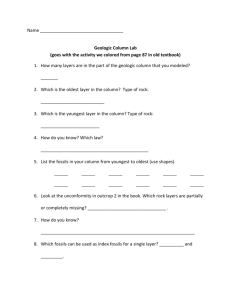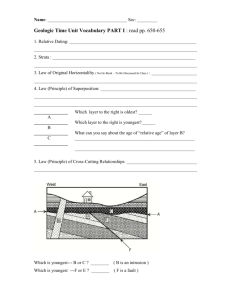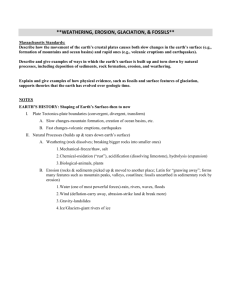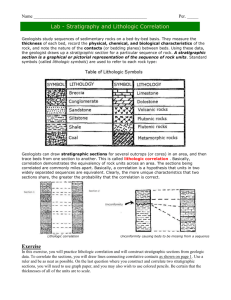P### Review for ESS Test 5 - Student Version
advertisement
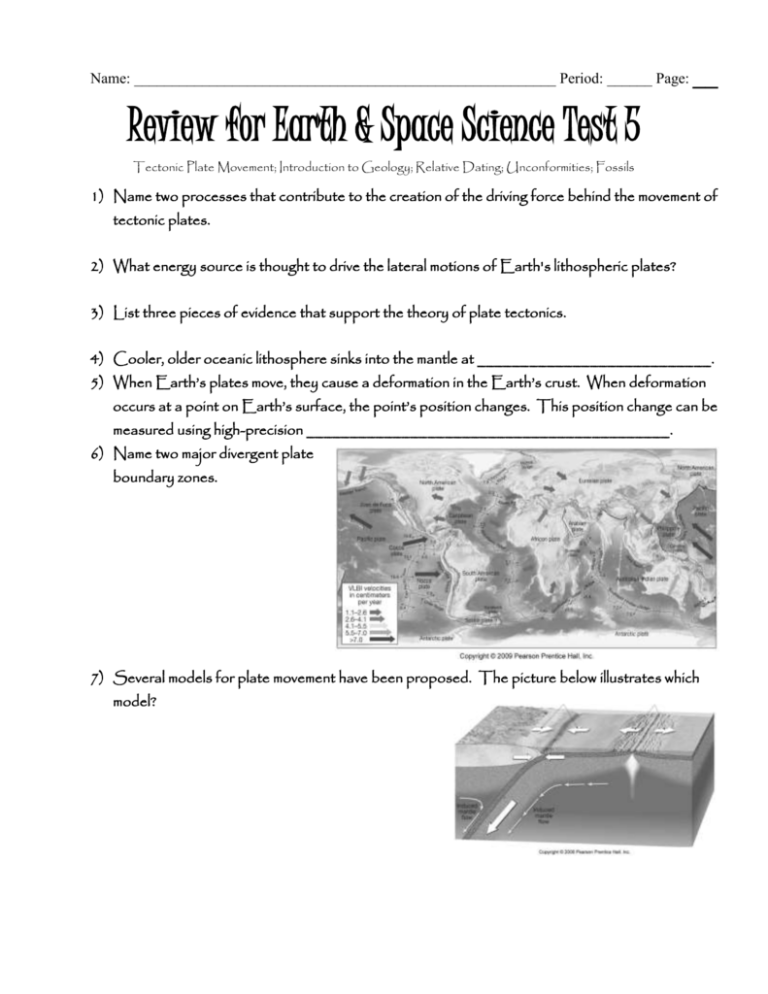
Name: ________________________________________________________ Period: ______ Page: __ Review for Earth & Space Science Test 5 Tectonic Plate Movement; Introduction to Geology; Relative Dating; Unconformities; Fossils 1) Name two processes that contribute to the creation of the driving force behind the movement of tectonic plates. 2) What energy source is thought to drive the lateral motions of Earth's lithospheric plates? 3) List three pieces of evidence that support the theory of plate tectonics. 4) Cooler, older oceanic lithosphere sinks into the mantle at ___________________________. 5) When Earth’s plates move, they cause a deformation in the Earth’s crust. When deformation occurs at a point on Earth’s surface, the point’s position changes. This position change can be measured using high-precision __________________________________________. 6) Name two major divergent plate boundary zones. 7) Several models for plate movement have been proposed. The picture below illustrates which model? 8) The drawing at right is a guess as to the positions of the continents ________________________________. 9) Catastrophists believed that Earth’s landscapes had been developed primarily by great catastrophes. James Ussher, in the mid-1600s, concluded that the Earth was created about ______________________________________. 10) James Hutton’s Theory of the Earth put forth a fundamental principle of geology called “uniformitarianism.” This principle states that: 11) Relative dating means placing rocks in their proper sequence of formation. This technique only provides what information? 12) In the picture to the right, the colume that is labeled “Younger” and “Older” describes: 13) According to the Law of Superposition, put the layers in the correct order from oldest to youngest. 14) The Law of Superposition states that: 15) If you apply the Principle of Original Horizontality to this picture of the Grand Canyon, what statement could you make that would be correct? 16) The rock layers is this picture are folded at a steep angle, therefore: 17) We know that Dike A is younger than any of the rock layers because of: 18) The small inclusions in the intrusive igneous rock layer prove that: 19) An unconformity represents a long period during which deposition ceased, erosion removed previously formed rocks, and then deposition resumed. In other words, it’s a break in the rock record. Name the three types of unconformities: __________________________________ 20) The unconformity in this picture can be classified as: 21) The unconformity in this picture can be classified as: Use the picture below to answer the next three questions 22) The point labeled A represents a(n): 23) The point labeled B represents a(n): 24) The point labeled C represents a(n): 25) List all fatures in this picture in order from oldest to youngest. 26) This picture best illustrates a(n): 27) Fossils are important inclusions in sediment and sedimentary rocks. Fossils can be defined as: 28) The study of fossils is called __________________________. 29) The fossils in the picture could best be described as: 30) Which of the following fossils would yield the greatest amount of information about the ancient organism? A B 31) The fossil in this picture is most likely: 32) This picture shows a single fossil that has been: 33) These three fossils are all considered to be: C D 34) List four example of indirect fossil evidence.? 35) What’s does this picture show? 36) List these fossils in order from oldest to youngest. 37) What two things were most useful in creating the Geologic Time Scale?

